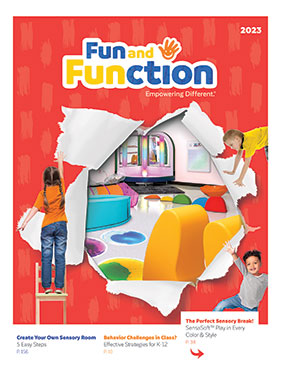Stimming is most commonly associated with autism. However, we all engage in some sort of “stim” behavior. Maybe you are on a crowded bus and feel anxious because there are too many people, so you cover your ears and hum to tune out the noise. Or perhaps you’re excited to see a good friend again after vacation, so you clap repeatedly. These stims, or self-stimulating behaviors, help you self-regulate and feel good.
What Are Stims?
Typically, self-stimulating behaviors are repetitive sounds or movements. People often think of hand flapping or rocking back and forth. If you observe the people around you, you’ll likely discover some “less conspicuous” forms of stims. When you tap your fingers on your thigh, blink rapidly, or click your tongue over and over again, you are stimming.
There are numerous reasons for a certain stim to occur, and it’s different for everyone. Stims can help soothe a negative physical sensation, provide sensory input, express your emotional state, or allow you to “escape” the world around you.
Stimming Do’s And Don'ts
Provided the behavior is not harmful or unsafe, it is important to recognize what stims are doing for yourself or others.
1. Do encourage safe stimming
Even though stimming is beneficial for self-regulation, it’s not good if you’re physically harming yourself. If you or someone else bangs your head on the wall or scratches your arms when stimming, find an alternative behavior that can provide the same type of sensory input in a safe way. An occupational therapist can help you identify an alternative.
2. Do recognize and accept that stims are okay
We all stim, whether we realize it or not. These self-soothing behaviors are part of being a human with a sensory system. When you see a person whose stim seems more “obvious” to you, recognize that they are self-regulating. It’s great!
3. Don’t create a “no stim” space
By taking away a stim, you’ll need to replace that behavior with something else to fill the same sensory need. Consider if the stim prevents you from engaging in the task at hand; if not, then continue doing it to self-regulate! However, if the behavior is harmful, or otherwise not helping you, find a more constructive way to get that sensory input rather than simply stopping the stim altogether.
4. Don’t ignore possible triggers
While not all stims are caused by a negative trigger, it is important to be observant and recognize when they are. If you get overwhelmed by loud noises and snap your fingers repeatedly in loud environments, then it could be helpful to find a way to reduce the noise. Wearing noise reduction headphones in the crowded cafeteria could help you stay one step ahead of things so that you don’t get triggered by the noise.
Whether you crack your knuckles, bounce on the balls of your feet, or bite chewies, embrace your stims. These behaviors can empower you to participate in situations you may not otherwise feel equipped to handle!
Do you notice when you are stimming? What type of self-soothing behavior helps you? We’d love to hear your stim stories! Leave them in the comments below, send us a message on Instagram, or email us at customercare@funandfunction.com.





















Comments